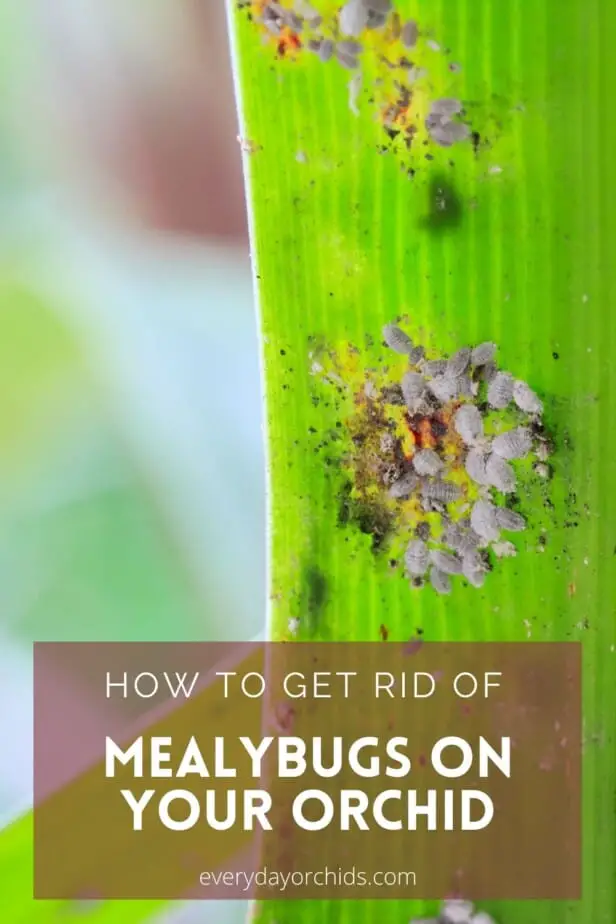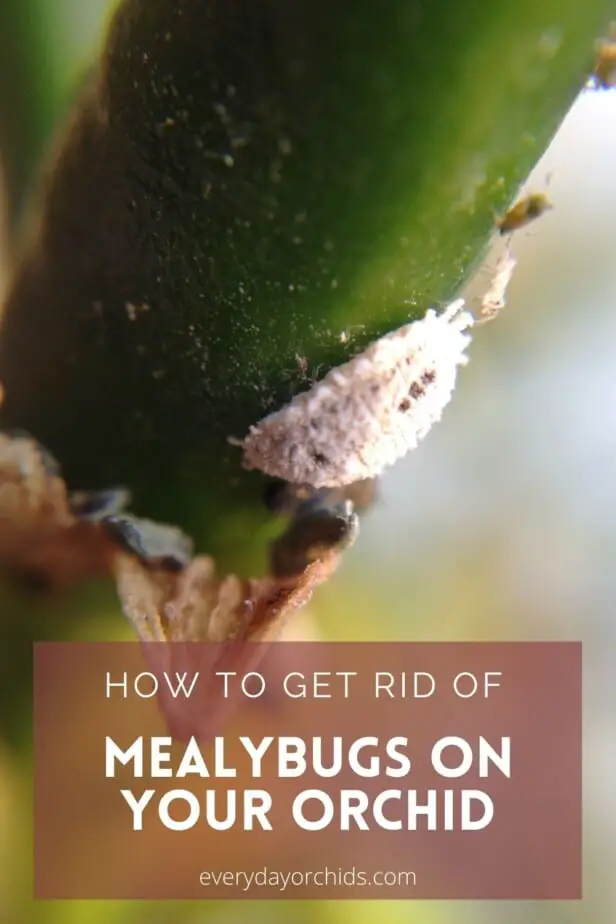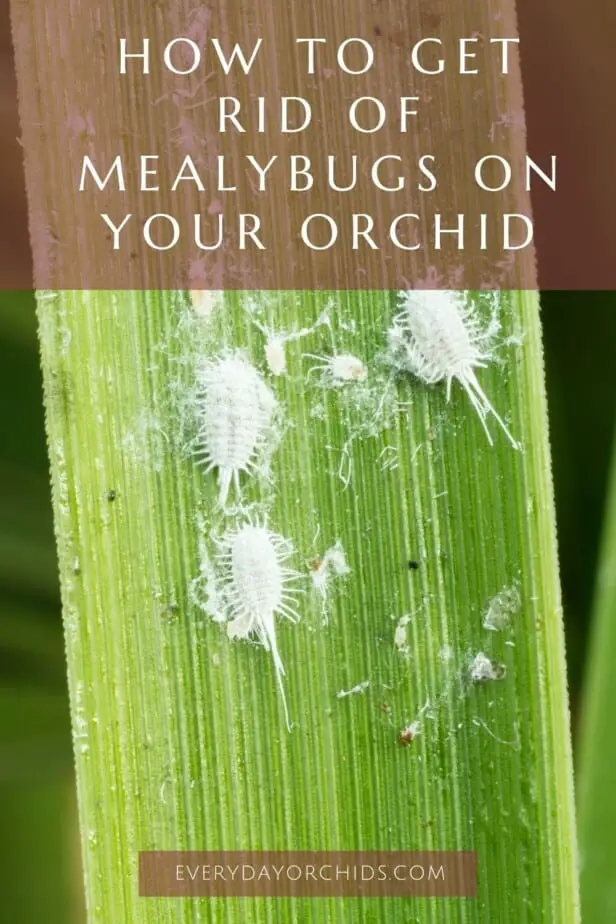Let’s talk about how to get rid of mealybugs on your orchids. Ever notice some white fuzz or fluff on your orchid and wonder what it is? If it’s found in the crevices of the orchid or on underside of the orchid leaves, there’s a good chance that this white “fuzz” is actually a mealybug or group of mealybugs.
Mealybugs are common orchid pests that, if left alone, can quickly become an infestation and a big headache for an orchid grower.
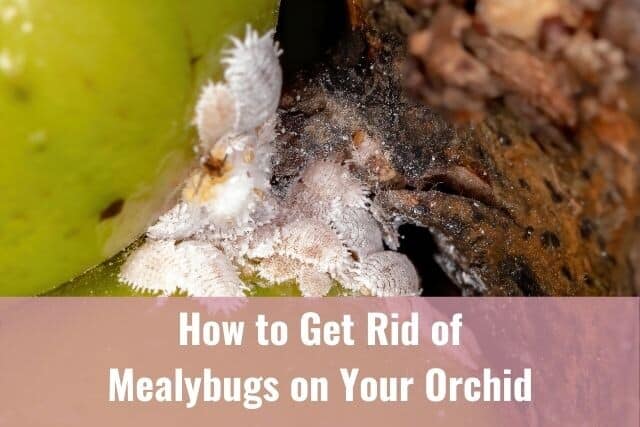
To get rid of mealybugs on your orchids, you can use a variety of home remedies, such as 70% isopropyl alcohol, a soap and water mixture, or neem oil. Insecticides and repotting your orchid are other options for handling a mealybug infestation. In the end though, prevention and early detection are key to preventing a widespread infestation and getting the existing mealybugs under control quickly.
If you are curious about how to get rid of mealybugs from your orchids, keep reading to learn more!
Please note that these links are affiliate links and as an Amazon Associate, I earn from qualifying purchases. Purchases made through affiliate links in this post may generate commissions at no additional cost to you. Use this link for a discounted Amazon Prime trial. Thank you for your support!
Table of Contents
How Do Orchids Get Mealybugs?
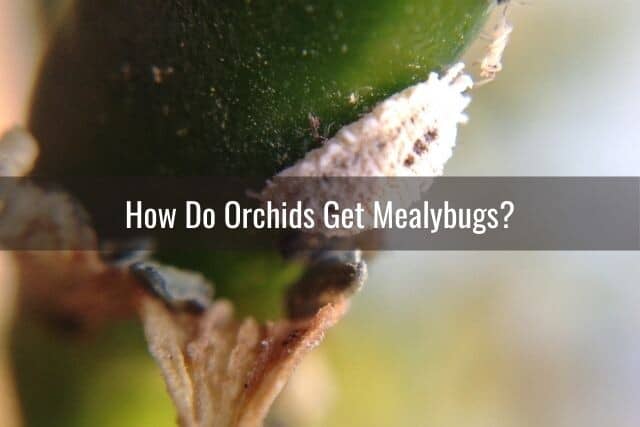
All plants can get mealybugs, unfortunately. These are one of the hardest to control pests and early intervention is necessary to successfully get rid of mealybugs.
Mealybugs are wingless insects that can readily travel from plant to plant. If your orchids are outdoors, they can be infested with mealybugs from neighboring plants.
For indoor orchids, infestation can occur when an infected orchid is brought inside and placed within the orchid collection. This is partly why it is so important to isolate new orchids that are gifted or bought from the store.
Mealybugs are very active insects and do not just stay in one pot or plant. Instead, they like to crawl from plant to plant in search of food. Wind and air currents can also pick up young mealybugs and carry them to new plants.
This is why isolating new plants is so important. It will help ensure that there are not any hidden pests or diseases in that new plant that go on to infect the rest of your collection.
Mealybugs can also come from contaminated potting media, so before you repot your orchid, thoroughly check the orchid potting media for pests.
What is the Life Cycle of a Mealybug?
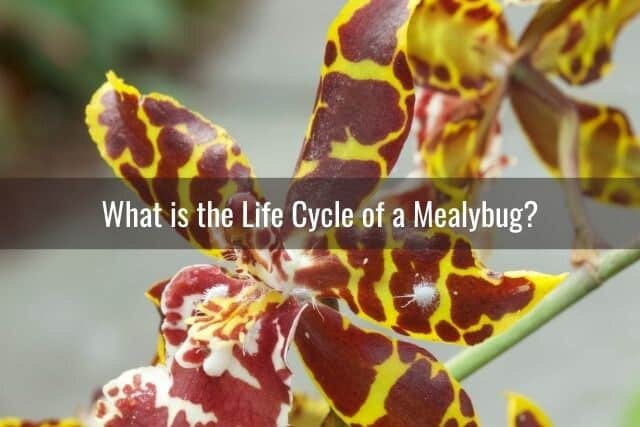
What is the life cycle of a mealybug? In other words, how fast do mealybugs grow and multiply? Knowing the life cycle of a mealybug is important for understanding how quickly a mealybug infestation can take over your orchid.
There are three parts to the mealybug life cycle: eggs, larvae (nymph/immature mealybug), and adult. The life cycle of a mealybug is about 30 days.
Adult female mealybugs can give birth to live mealybug “children,” or lay eggs (it varies depending on the type of mealybug).
Clusters of eggs will look like a white mass of wax. These are usually found in the crevices of orchids, such as where the leaves join the stems.
After 10 days, the eggs hatch into nymphs. Nymphs are mobile and can crawl around, looking for food.
Nymphs are immature mealybugs. They will crawl everywhere on your orchid. If you have neighboring orchids nearby, they will crawl to those plants too. Mealybugs are most active in this stage of development and will easily spread from plant to plant.
Once these nymphs start to feed on your orchid, they will develop a white filament over their body. This gives the pest a cotton-y appearance. They will then quickly develop into adult mealybugs. Adult mealybugs will then lay eggs and the cycle begins again.
How to Spot Mealybugs in Your Orchid
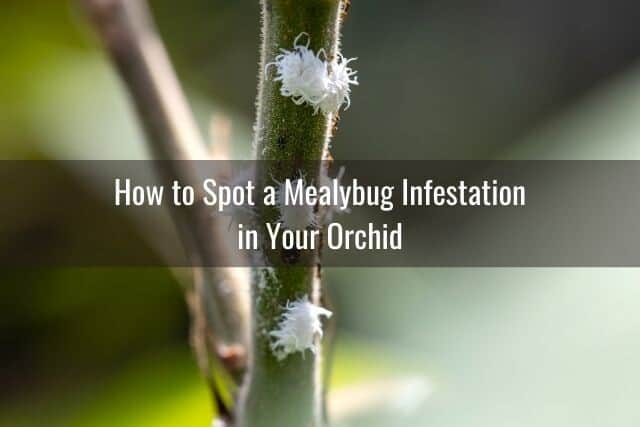
Daily inspection, or at least, regular inspection, of your orchids is an essential part of orchid care. Early detection is key to fighting a mealybug infestation. The question is, what do mealybug infestations look like in orchids?
From afar, mealybugs look like fuzzy, white bits of fluff on the orchid. A cluster of mealybugs might look like cotton, mold, or fuzz.
However, if you look closer, you will see that each bit of “fuzz” actually has a long, oval shaped body, multiple legs on each side, and long antennae in the front. These are the adult mealybugs.
Places Where Mealybugs Like to Hide
Mealybugs love to hide in the cracks and crevices of plants, orchids included. You will often find mealybugs on the underside of orchid leaves, in the crevices such as the orchid crown, and where the leaves meet the stem.
Mealybugs will also hide in flowers, flower buds, in the joints and branches of the flower spike, so check there as well.
You might also find mealybugs in the potting media or near the roots as well.
Since mealybugs tend to travel between plants, you’ll also want to check the edges of your pots and under the lips of pots. Also check for mealybugs around the general area where your orchids and other plants are housed.
How Do Mealybugs Hurt Your Orchid?
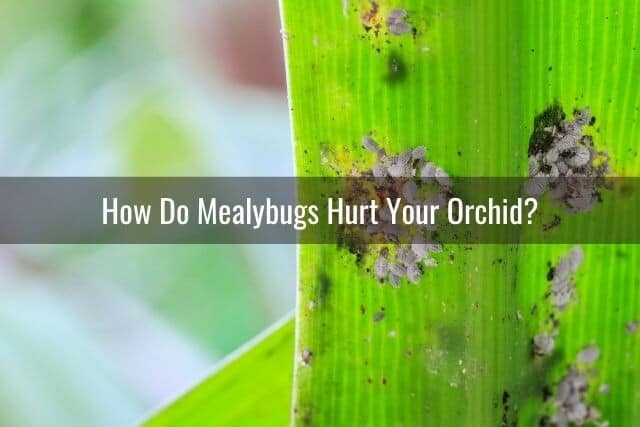
Unfortunately, mealybugs can do a lot of damage to orchids. Once an infestation is identified, you have to take action as soon as possible. As evidenced by the mealybug life cycle outlined above, a mealybug infestation can quickly explode to take over your orchid.
Mealybugs feed on plant tissue. Using their mouthparts, mealybugs will break into the orchid tissue and suck the sap and nutrients from the plant.
Over time, this will result in your orchid’s leaves curling, yellowing leaves, stunted growth, and reduced flower production.
Mealybugs will also excrete a sticky clear liquid called honeydew. This is because they are unable to digest all the sugar in the sap. You may notice tiny drops of the honeydew on your orchid in a mealybug infestation.
This is honeydew excretion can lead to black sooty mold fungus on your orchids. The black sooty mold will spread and if left untreated, will soon cover the orchid leaves. This will block photosynthesis and further stunt orchid growth.
The honeydew excreted by mealybugs will also attract other pests, such as ants. This obviously will lead to other insect infestations and bigger problems.
A mealybug infestation by itself will weaken the orchid plant. But if nothing is done and the mealybugs are left to multiply, the orchid may eventually succumb to the infestation and related disease and die.
How to Get Rid of Mealybugs on Your Orchid
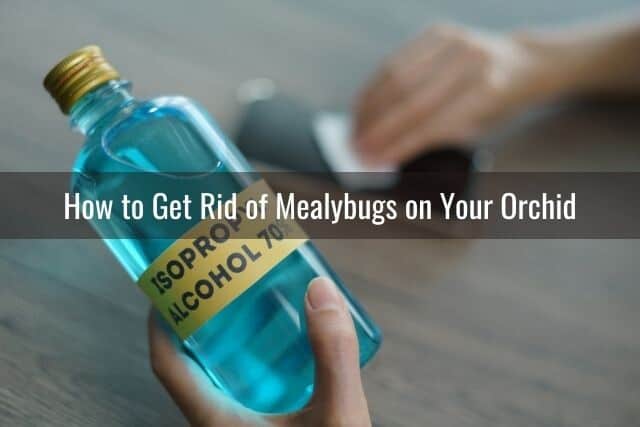
As I have already mentioned, quick action is necessary once you spot mealybugs on your orchid.
If you see one or two mealybugs lurking in your orchid, chances are, there are more hidden in the orchid crevices or under the leaves or in the potting media.
Don’t worry though! You can successfully get rid of mealybugs on your orchid. Isolate the infected plant or plants and use the methods below to kill the mealybugs.
Start dealing with the mealybug infestation early before it gets worse. To get rid of mealybugs on your orchid, you have several options, ranging from home remedies to insecticides. I’ll go over each option below.
Rubbing Alcohol
One of the most popular ways to deal with a mealybug infestation is to use rubbing alcohol. This is also possibly the cheapest and easiest method as well.
When I find mealybugs on my orchids, rubbing alcohol is my go-to method for killing these pests. It doesn’t hurt the orchid and its very effective.
Before you begin, be sure you are using 70% isopropyl alcohol. This is very important. Don’t use ethanol or methanol because these can damage the orchid leaves. Instead, use 70% isopropyl alcohol. This is the same as the rubbing alcohol you will find in the first-aid section of the store, used to disinfect cuts and scrapes. You will need cotton swabs as well.
Soak the end of a cotton swab in rubbing alcohol. Then, use the cotton swab to remove mealybugs from your orchid plant.
You can also use a soft toothbrush or cotton ball soaked in 70% isopropyl alcohol to remove the mealybugs, but I find cotton swabs are the easiest to work with.
Make sure you get all the crevices and hiding spots of the mealybugs with the 70% isopropyl alcohol! You may have to use both ends of multiple cotton swabs to get every mealybug.
If you see mealybugs in the orchid crown or in crevices you can’t reach, just drip a few drops of isopropyl alcohol into those spaces. The rubbing alcohol will dissolve the mealybug’s waxy coating and kill it on contact.
If you see any tiny yellow spots on the orchid, be sure to remove those as well with the isopropyl alcohol. There is a good chance that these little yellow spots are newly hatched mealybugs, so you want to make sure you kill those as well.
Soap and Water
Alternatively, you can “wash” off the mealybugs with soap and water. Soap will “suffocate” the mealybug eggs and larvae.
Mix 3 drops of liquid castile soap with half a cup of water and half a cup of isopropyl alcohol and pour this mixture into a spray bottle.
Spray this concoction over your orchids, making sure you get the underside of the leaves, potting media, and all the mealybug hiding places.
Do this daily until you see that the mealybugs are all gone. When spraying your orchids, do it early in the day so that they can dry off by nighttime. Also make sure you have good air circulation around your orchids to help expedite drying and prevent disease.
Neem Oil
Neem oil is a popular treatment option in organic gardening. It works by preventing mealybug pupa and larvae from growing into adults. It also prevents the adults from reproducing, breaking the mealybug life cycle.
However, neem oil doesn’t kill the mealybugs, so you will still have to use other options like rubbing alcohol to eliminate the existing pests.
Bonide Neem Oil is one of the most popular neem oil products out there. It is often sold as a mist spray and is a fungicide, miticide and insecticide. You can use this to not just treat mealybugs on your orchids, but aphids and spider mites as well.
To use neem oil sprays, simply mist the entire orchid with the neem oil, making sure you spray all the hiding areas of mealybugs.
After 7 days has passed, check the orchid over and spray again, repeating once a week until all the mealybug larvae, pupae and eggs are gone.
If you are buying concentrated neem oil, simply mix 4 to 5 tablespoons of neem oil in 1 gallon of water. Pour the mixture into a spray bottle and apply as above.
Malathion Insect Control
If you have a widespread mealybug infestation, you might want to opt for an insecticide spray to address the mealybugs. Painstakingly using q-tips and rubbing alcohol to eliminate the mealybugs from your orchids might not be an option if you have a severe infestation, a lot of orchids, or both.
One option you can use is the Bonide Malathion Insecticide Control. This is a concentrate so be sure to follow the product directions for dilutions. You can use this on many sap-sucking insects, including mealybugs.
Spray the malathion insecticide over the orchids where you see mealybugs. Be sure to get the potting media where mealybugs might be hiding.
Similar to neem oil, you may want to do another pass or two within 4 to 5 days if you still see mealybugs.
Treat plants early in the morning and don’t water your orchids right after. Watering the orchids will just wash away the insecticide spray. Of course, make sure the area is well-ventilated to help the fumes and chemical smells dissipate.
Keep in mind that commercial insecticides are essentially a poison used to kill insects. Use this as your last resort, since the chemicals might affect your orchids as well.
In a severe infestation, your orchid is likely weak and stressed, and exposure to insecticide will stress it further. Sometimes, you have no other option but to use a spray insecticide in a widespread infestation, but just use caution and be aware of the risks.
Repot Your Orchid
In a severe infestation, there are likely mealybug eggs, larvae, and possibly even adult mealybugs hiding in the potting media near the roots. You can do all you can to eliminate the mealybugs on the top of the plant, but until the mealybugs in the potting media are addressed, they will keep coming back.
In this case, you will need to repot your orchid. It is also very important that you get rid of all the old potting media (throw it away!) and use fresh orchid potting media. You can buy a ready-to-use bag of orchid potting media such as this one by rePotme, or make your own.
If you are interested in making your own custom orchid potting media mix, be sure to learn more about orchid potting media and what each component is for. This way, you will be able to decide how much of each item to use in your custom potting mix.
If you are repotting your orchid because of a mealybug infestation, be sure you clean off the roots and all the crevices within the roots where mealybugs might be hiding. Use a fresh clean orchid pot. If you are using the old orchid pot, be sure to first sterilize and disinfect it with a 10% bleach solution before using it again.
How to Prevent a Mealybug Infestation in Your Orchid
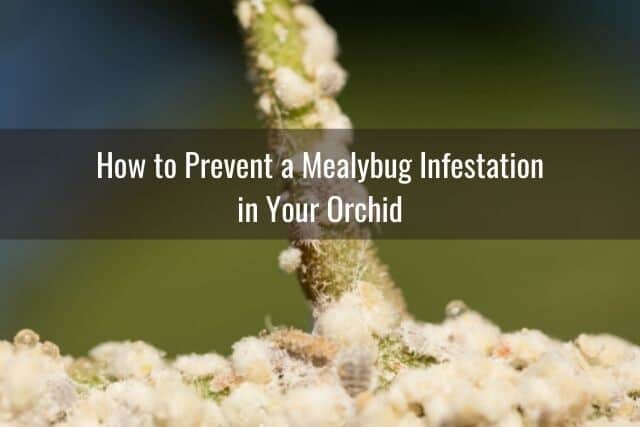
As they say, an ounce of prevention is worth a pound of cure. Here are some easy ways to prevent mealybugs from infecting your orchid.
Isolate New Plants
I mentioned this earlier, but whenever you bring a new orchid home, you want to keep it isolated and away from the rest of your orchid collection for at least two weeks.
The main point is that you never know what pests or diseases your new orchid could be harboring. A two-week quarantine period is usually enough time for problems to reveal themselves. This way, you can just treat one orchid rather than your whole collection.
Regularly Inspect Your Orchid
After isolating any new orchids or plants, regular inspections of your orchid collection are probably the most important preventative measure you can take.
If you can spot a mealybug infestation early, it will be much easier to eliminate the small number of bugs before they can multiply and do damage to your orchid.
If you find a mealybug or two, spot treat it with rubbing alcohol and a cotton swab right away. Check under orchid leaves, in the orchid crown, and in the crevices where the leaves meet the stem.
Mealybugs have also been known to hide in orchid flowers, near the buds, and in the branches of orchid flower spikes. Also check the potting media, along the edges of the orchid pot and along the base of the orchid stem.
Regularly Prune Your Orchid
Pruning your orchid is an essential part of routine orchid care. By pruning your orchid, you are also minimizing any potential hiding places for mealybugs.
Remove all old, dead plant debris. Also prune away any old, dead leaf sheaths that might offer mealybugs a place to hide.
When pruning your orchid, be sure you use a pair of sterilized gardening shears or scissors. “Sterilized” is key, so that you don’t inadvertently expose your orchid to other bacteria, virus, or fungus. Clean your gardening shears between cuts with a bleach solution or rubbing alcohol.
You can use an anti-fungal powder or ground cinnamon to cover any open orchid cuts or wounds. This will help prevent infection and also seal off the open ends.
Repot Your Orchid
Mealybugs have been known to hide in the orchid potting media and eat the roots. If your orchid potting media is old, you may want to consider repotting, especially if you have just gone through a mealybug infestation.
If this is the case, repot your orchid with fresh, new orchid potting media. This will eliminate the chance that any mealybug eggs hidden in the old potting media will hatch and re-infest your orchid.
Even if your orchid’s potting media doesn’t have evidence of a mealybug infestation, it is still a good idea to repot your orchid every couple of years. Potting media breaks down over time into smaller pieces, leading to decreased air circulation around the roots and increased moisture. This, in turn, raises the chances that your orchid will have problems like root rot.
If you are new to orchid growing, or would just like a refresher on how to repot your orchid, check out my other article that has a step-by-step guide on how to repot an orchid.
Final Thoughts
Finding mealybugs in or around your orchid can be stressful, but don’t worry! You can handle this with some simple interventions.
Mealybugs can easily be killed and removed from your orchid using 70% isopropyl alcohol and a cotton swab. It will take some effort and diligence on your part. If you are able to keep up daily inspections and treatment until all the mealybugs are gone, you will be able to eradicate all the mealybugs.
If the isopropyl alcohol doesn’t work, you have other options as well, as I mentioned above. Moving forward, use the tips outlined in this article to prevent future mealybug infestations from affecting your orchid.
Hope this helps and best of luck!
If you enjoyed this article, please pin it and share!
